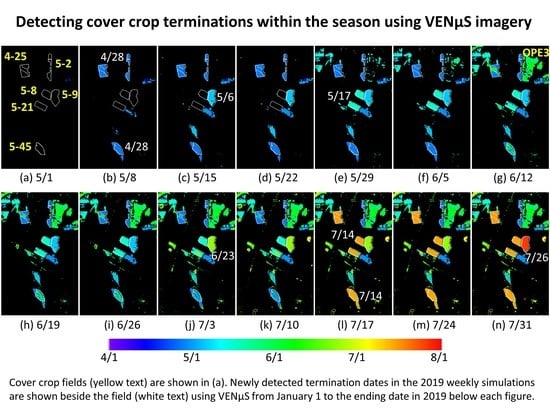Detecting Cover Crop End-Of-Season Using VENµS and Sentinel-2 Satellite Imagery
Abstract
1. Introduction
2. Materials
2.1. Study Area
2.2. Satellite and Ground Data
2.2.1. VENµS Data
2.2.2. Sentinel-2 Data
2.2.3. Cover Crop Termination Records
3. Methods
3.1. WIST Algorithm
3.1.1. Generating Daily NDVI
3.1.2. Finding the Senescent Period
3.1.3. Estimating Termination Date and Uncertainty
- Find all original clear satellite observations between dates “s” and “d”. If there is no satellite observation on the dates “s” and “d,” the first clear observations before date “s” and the first clear observations after date “d” will be used as the bracketing observations.
- Compute the rate of NDVI decrease between all adjacent observations in the set identified in step 1.
- Select the period with the most-rapid rate of decrease from step 2 (i.e., date “t1” and “t2” in Figure 4).
- Estimate termination date “t” using the mid-date between the two observations from step 3 (i.e., t = (t1 + t2)/2 in Figure 4). The uncertainty of the estimation is computed using half of the date range between the two observations, i.e., uncertainty = (t2 − t1)/2.
3.2. Algorithm Assessment
4. Results
4.1. Algorithm Evaluation Using an Alfalfa Pixel
4.2. Field-Level Results from VENµS
4.3. Field-Level Results from Sentinel-2
4.4. Field Results from VENµS and Sentinel-2
4.5. Near-Real-Time Mapping
5. Discussion
5.1. Performance and Comparison
5.2. Constraints and Limitations
6. Conclusions
Author Contributions
Funding
Acknowledgments
Conflicts of Interest
References
- Carlson, S.; Stockwell, R. Research priorities for advancing adoption of cover crops in agriculture-intensive regions. J. Agric. Food Syst. Commun. Dev. 2013, 3, 125–129. [Google Scholar] [CrossRef]
- Dabney, S.A.; Delgado, J.A.; Reeves, D.W. Using winter cover crops to improve soil and water quality. Commun. Soil Sci. Plant. Anal. 2001, 32, 1221–1250. [Google Scholar] [CrossRef]
- Reeves, D.W. Cover crops and rotations. In Crops Residue Management (Advances in Soil Science); Hatfield, J.L., Stewart, B.A., Eds.; Lewis Publishers: Boca Raton, FL, USA, 1994; pp. 125–172. [Google Scholar]
- Sullivan, P. Overview of Cover Crops and Green Manures. National Center for Appropriate Technology. 2003. Available online: https://attra.ncat.org/product/Overview-of-Cover-Crops-and-Green-Manures/ (accessed on 21 September 2020).
- De Baets, S.; Poesen, J.; Meermans, J.; Serlet, L. Cover crops and their erosion-reducing effects during concentrated flow erosion. Catena 2011, 85, 237–244. [Google Scholar] [CrossRef]
- Hively, W.D.; Lang, M.; McCarty, G.W.; Keppler, J.; Sadeghi, A.; McConnell, L.L. Using satellite remote sensing to estimate winter cover crop nutrient uptake efficiency. J. Soil Water Conserv. 2009, 64, 303–313. [Google Scholar] [CrossRef]
- Hively, W.D.; Lee, S.; Sadeghi, A.; McCarty, G.W.; Yeo, I.-Y.; Moglen, G. Estimating the effect of winter cover crops on nitrogen leaching using cost-share enrollment data, satellite remote sensing, and Soil and Water Assessment Tool (SWAT) modeling. J. Soil Water Conserv. 2020, 75, 362–375. [Google Scholar] [CrossRef]
- Chesapeake Bay Program. Cover Crops Practices for use in Phase 6.0 of the Chesapeake Bay Program Watershed Model. Available online: https://www.chesapeakebay.net/documents/Phase_6_CC_EP_Final_Report_12-16-2016-NEW_TEMPLATE_FINAL.pdf (accessed on 21 September 2020).
- Maryland Department of Agriculture. 2019/2020 Winter Cover Crop for Nutrient Management. Available online: https://mda.state.md.us/resource_conservation/counties/FY20_Program%20Requirements%20and%20Agreement_website.pdf (accessed on 21 September 2020).
- Lawson, A.; Cogger, C.; Bary, A.; Fortuna, A. Influence of seeding ratio, planting date, and termination date on rye-hairy vetch cover crop mixture performance under organic management. PLoS ONE 2015, 10, e0129597. [Google Scholar] [CrossRef] [PubMed]
- Hunt, E.R., Jr.; Hively, W.D.; McCarty, G.W.; Daughtry, C.S.T.; Forrestal, P.J.; Kratochvil, R.J.; Carr, J.L.; Allen, N.F.; Fox-Rabinovitz, J.R.; Miller, C.D. NIR-Green-Blue High-Resolution Digital Images for Assessment of Winter Cover Crop Biomass. GISci. Remote Sens. 2011, 48, 86–98. [Google Scholar] [CrossRef]
- Prabhakara, K.; Hively, W.D.; McCarty, G.W. Evaluating the relationship between biomass, percent groundcover and remote sensing indices across six winter cover crop fields in Maryland, United States. Int. J. Appl. Earth Obs. Geoinf. 2015, 39, 88–102. [Google Scholar] [CrossRef]
- Thieme, A.; Yadav, S.; Oddo, P.C.; Fitz, J.M.; McCartney, S.; King, L.; Keppler, J.; McCarty, G.W.; Hively, W.D. Using NASA Earth observations and Google Earth Engine to map winter cover crop conservation performance in the Chesapeake Bay watershed. Remote Sens. Environ. 2020, 248. [Google Scholar] [CrossRef]
- European Space Agency (ESA). Sentinel-2 User Handbook. Available online: https://sentinels.copernicus.eu/documents/247904/685211/Sentinel-2_User_Handbook (accessed on 21 September 2020).
- Claverie, M.; Ju, J.; Masek, J.G.; Dungan, J.L.; Vermote, E.F.; Roger, J.-C.; Skakun, S.V.; Justice, C. The Harmonized Landsat and Sentinel-2 surface reflectance data set. Remote Sens. Environ. 2018, 219, 145–161. [Google Scholar] [CrossRef]
- Houborg, R.; McCabe, M.F. A Cubesat enabled Spatio-Temporal Enhancement Method (CESTEM) utilizing Planet, Landsat and MODIS data. Remote Sens. Environ. 2018, 209, 211–226. [Google Scholar] [CrossRef]
- Dedieu, G.; Hagolle, O.; Karnieli, A.; Ferrier, P.; Crébassol, P.; Gamet, P.; Desjardins, C.; Yakov, M.; Cohen, M.; Hayun, E. VENµS: Performances and first results after 11 months in orbit. In Proceedings of the 2018 IEEE International Geoscience and Remote Sensing Symposium (IGARSS 2018), Valencia, Spain, 22–27 July 2018. [Google Scholar] [CrossRef]
- Bar-Massada, A.; Sviri, A. Utilizing Vegetation and Environmental New Micro Spacecraft (VENµS) data to estimate live fuel moisture content in Israel’s mediterranean ecosystems. IEEE J. Sel. Top. Appl. Earth Obs. Remote Sens. 2020, 13, 3204–3212. [Google Scholar] [CrossRef]
- Gao, F.; Anderson, M.C.; Daughtry, C.S.; Karnieli, A.; Hively, W.D.; Kustas, W.P. A within-season approach for detecting early growth stages in corn and soybean using high temporal and spatial resolution imagery. Remote Sens. Environ. 2020, 242, 111752. [Google Scholar] [CrossRef]
- Jönsson, P.; Eklundh, L. TIMESAT—A program for analysing time-series of satellite sensor data. Comput. Geosci. 2004, 30, 833–845. [Google Scholar] [CrossRef]
- Zhang, X.; Friedl, M.A.; Schaaf, C.B.; Strahler, A.H.; Hodges, J.C.F.; Gao, F.; Reed, B.C. Monitoring vegetation phenology using MODIS. Remote Sens. Environ. 2003, 84, 471–475. [Google Scholar] [CrossRef]
- Gray, J.; Sulla-Menashe, D.; Friedl, M. User Guide to Collection 6 MODIS Land Cover Dynamics (MCD12Q2) Product. Available online: https://lpdaac.usgs.gov/documents/218/mcd12q2_v6_user_guide.pdf (accessed on 21 September 2020).
- Zhang, X.; Liu, L.; Liu, Y.; Jayavelu, S.; Wang, J.; Moon, M.; Henebry, G.M.; Friedl, M.A.; Schaaf, C.B. Generation and evaluation of the VIIRS land surface phenology product. Remote Sens. Environ. 2018, 216, 212–229. [Google Scholar] [CrossRef]
- Bolton, D.K.; Gray, J.M.; Melaas, E.K.; Moon, M.; Eklundh, L.; Friedl, M.A. Continental-scale land surface phenology from harmonized Landsat 8 and Sentinel-2 imagery. Remote Sens. Environ. 2020, 140, 111685. [Google Scholar] [CrossRef]
- Gao, F.; Anderson, M.; Zhang, X.; Yang, Z.; Alfieri, J.; Kustas, B.; Mueller, R.; Johnson, D.; Prueger, J. Toward mapping crop progress at field scales through fusion of Landsat and MODIS imagery. Remote Sens. Environ. 2017, 188, 9–25. [Google Scholar] [CrossRef]
- Roy, D.P.; Yan, L. Robust Landsat-based crop time series modelling. Remote Sens. Environ. 2020, 238, 110810. [Google Scholar] [CrossRef]
- Yan, L.; Roy, D.P. Spatially and temporally complete Landsat reflectance time series modelling: The fill-and-fit approach. Remote Sens. Environ. 2020, 241. [Google Scholar] [CrossRef]
- The Long-Term Agroecosystem Research (LTAR) Network. Available online: https://ltar.ars.usda.gov (accessed on 21 September 2020).
- The Theia Data Center. Available online: https://theia.cnes.fr/atdistrib/rocket/#/search?collection=VENUS (accessed on 21 September 2020).
- Hagolle, O.; Huc, M.; Desjardins, C.; Auer, S.; Richter, R. MAJA Algorithm Theoretical Basis Document (ATBD). Available online: https://www.theia-land.fr/wp-content-theia/uploads/sites/2/2018/12/atbd_maja_071217.pdf (accessed on 21 September 2020).
- European Space Agency. The Copernicus Open Access Hub. Available online: https://scihub.copernicus.eu/dhus/#/home (accessed on 21 September 2020).
- European Space Agency. The Sen2Cor tool. Available online: http://step.esa.int/main/third-party-plugins-2/sen2cor/sen2cor_v2-8/ (accessed on 21 September 2020).
- Main-Knorn, M.; Pflug, B.; Louis, J.; Debaecker, V.; Müller-Wilm, U.; Gascon, F. Sen2Cor for Sentinel-2. In Proceedings of the SPIE Remote Sensing 2017, Warsaw, Poland, 11–24 September 2017; Volume 1042704. [Google Scholar] [CrossRef]
- FarmLogic Systems. Available online: https://www.farmlogic.com/ (accessed on 21 September 2020).
- Appel, G. Technical Analysis Power Tools for Active Investors; Financial Times Prentice Hall: Upper Saddle River, NJ, USA, 2005; p. 166. [Google Scholar]
- Gao, F.; Masek, J.; Schwaller, M.; Hall, F. On the blending of the Landsat and MODIS surface reflectance: Predict daily Landsat surface reflectance. IEEE Trans. Geosci. Remote Sens. 2006, 44, 2207–2218. [Google Scholar]
- Gao, F.; Anderson, M.; Daughtry, C.; Johnson, D. Assessing variability of corn and soybean yields in central Iowa using high spatiotemporal resolution multi-satellite imagery. Remote Sens. 2018, 10, 1489. [Google Scholar] [CrossRef]
- The Harmonized Landsat-8 and Sentinel-2 (HLS) Data Product. Available online: https://hls.gsfc.nasa.gov/data/ (accessed on 21 September 2020).
- Yan, L.; Roy, D.P. Conterminous United States crop field size quantification from multi-temporal Landsat data. Remote Sens. Environ. 2016, 172, 67–86. [Google Scholar] [CrossRef]
- Liu, L.; Zhang, X.; Yu, Y.; Gao, F.; Yang, Z. Real-time monitoring of crop phenology in the midwestern United States using VIIRS observations. Remote Sens. 2018, 10, 1640. [Google Scholar] [CrossRef]
- Zhang, X.; Wang, J.; Henebry, G.M.; Gao, F. Development and evaluation of a new algorithm for detecting 30 m land surface phenology from VIIRS and HLS time series. J. Photogr. Remote Sens. 2020, 161, 37–51. [Google Scholar] [CrossRef]
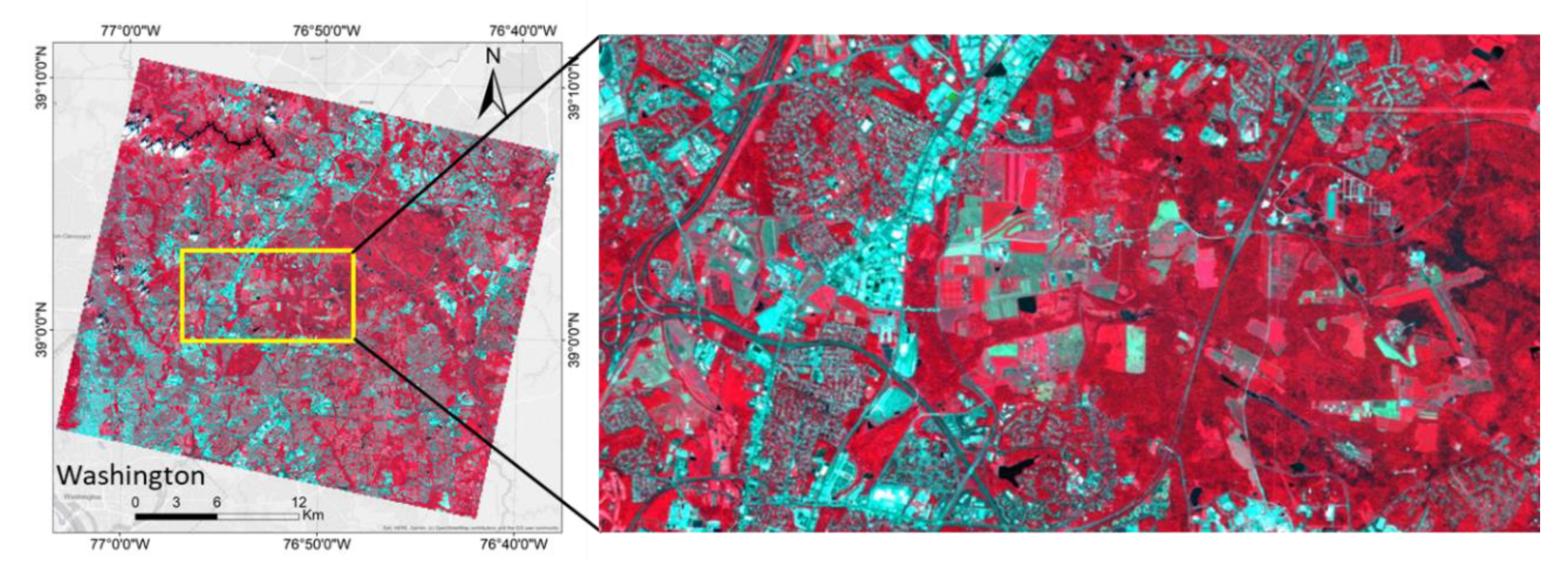
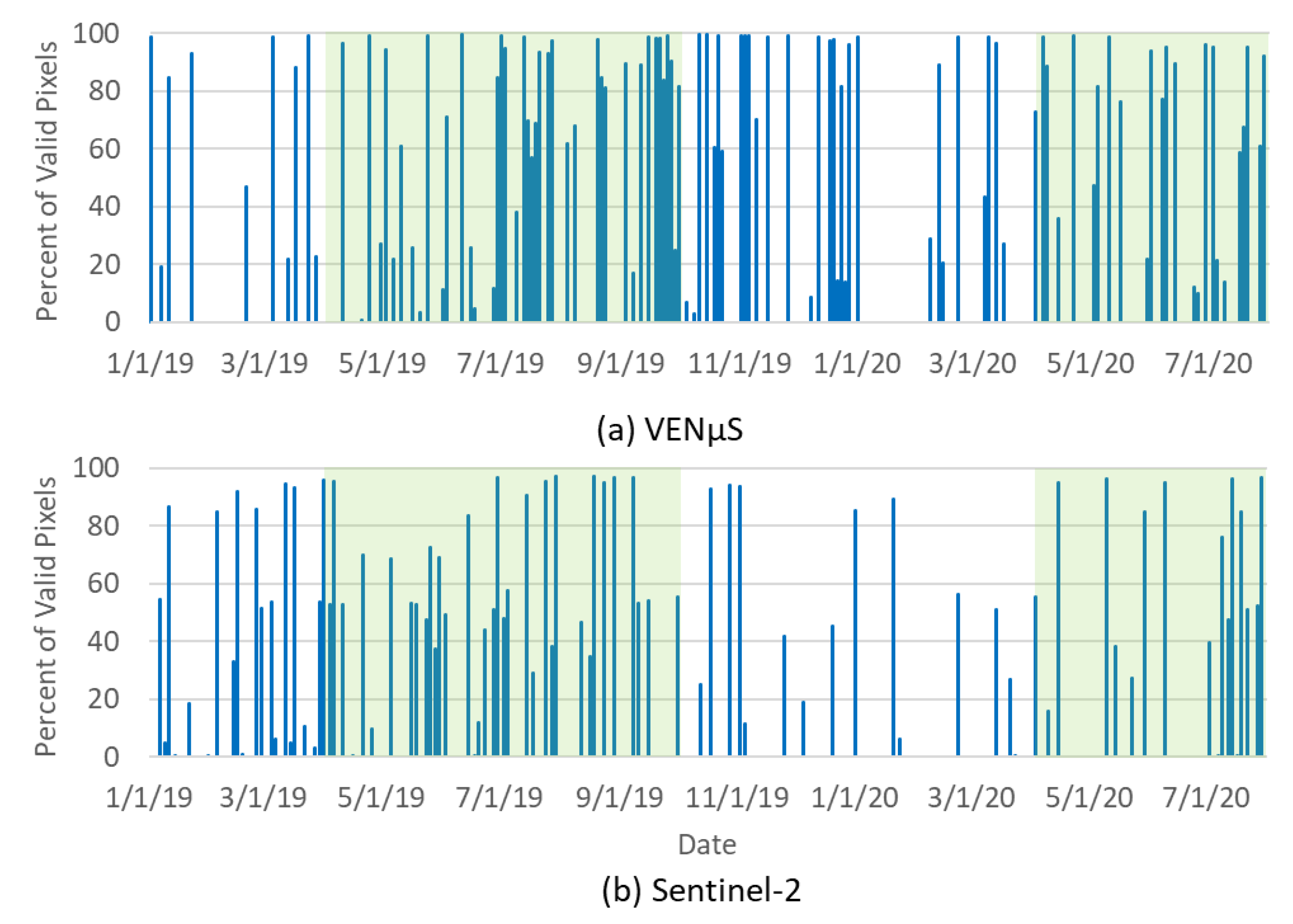
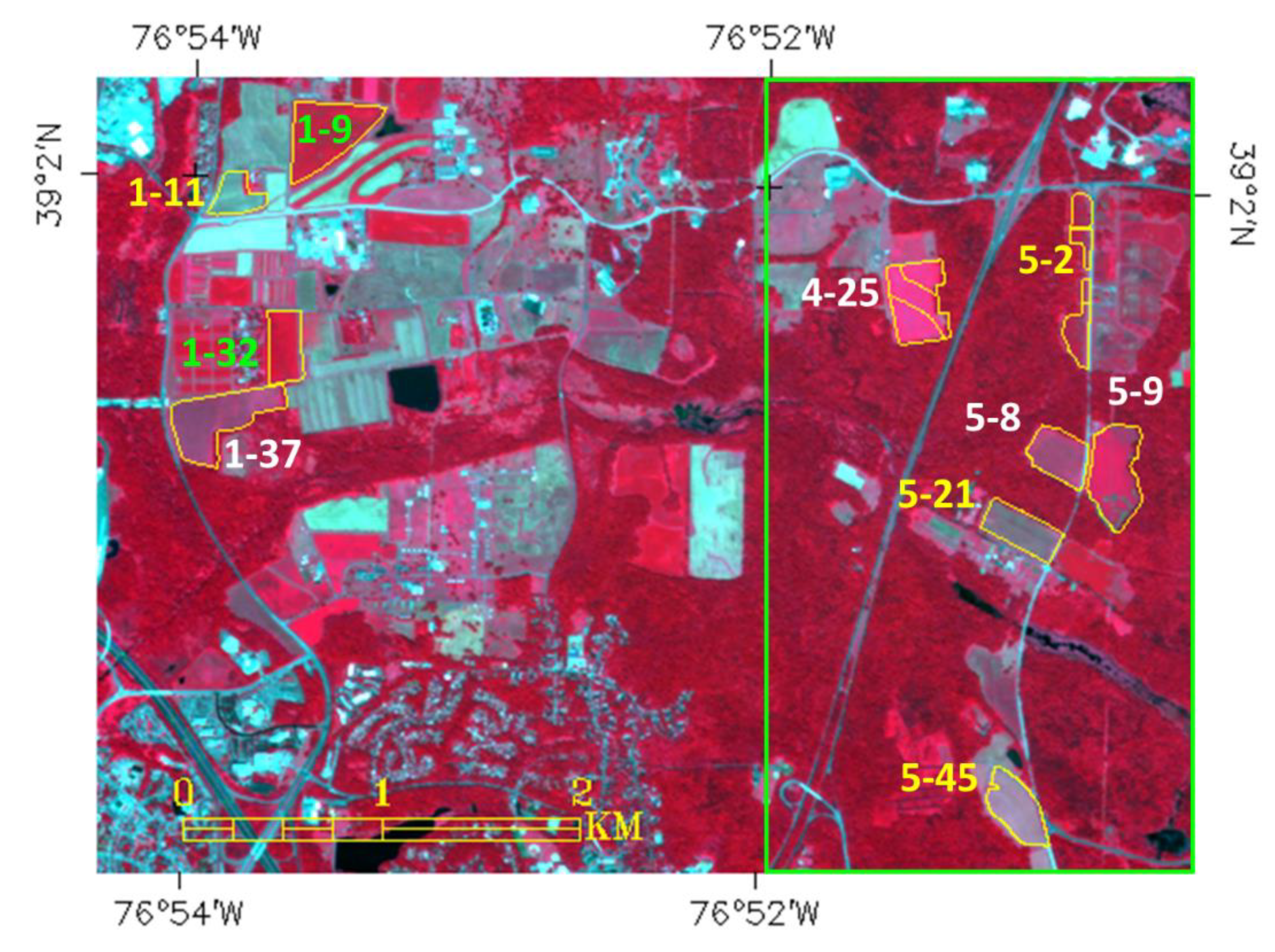
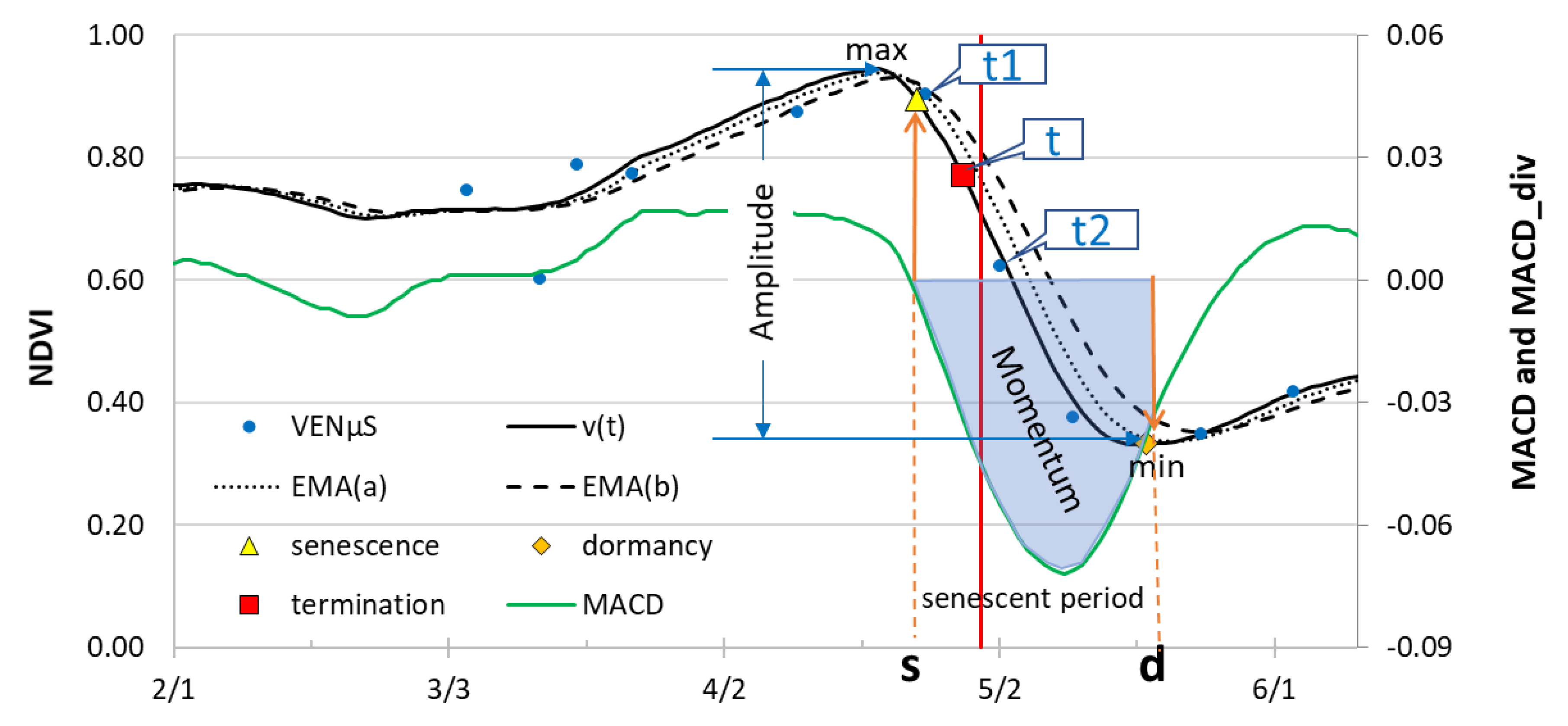
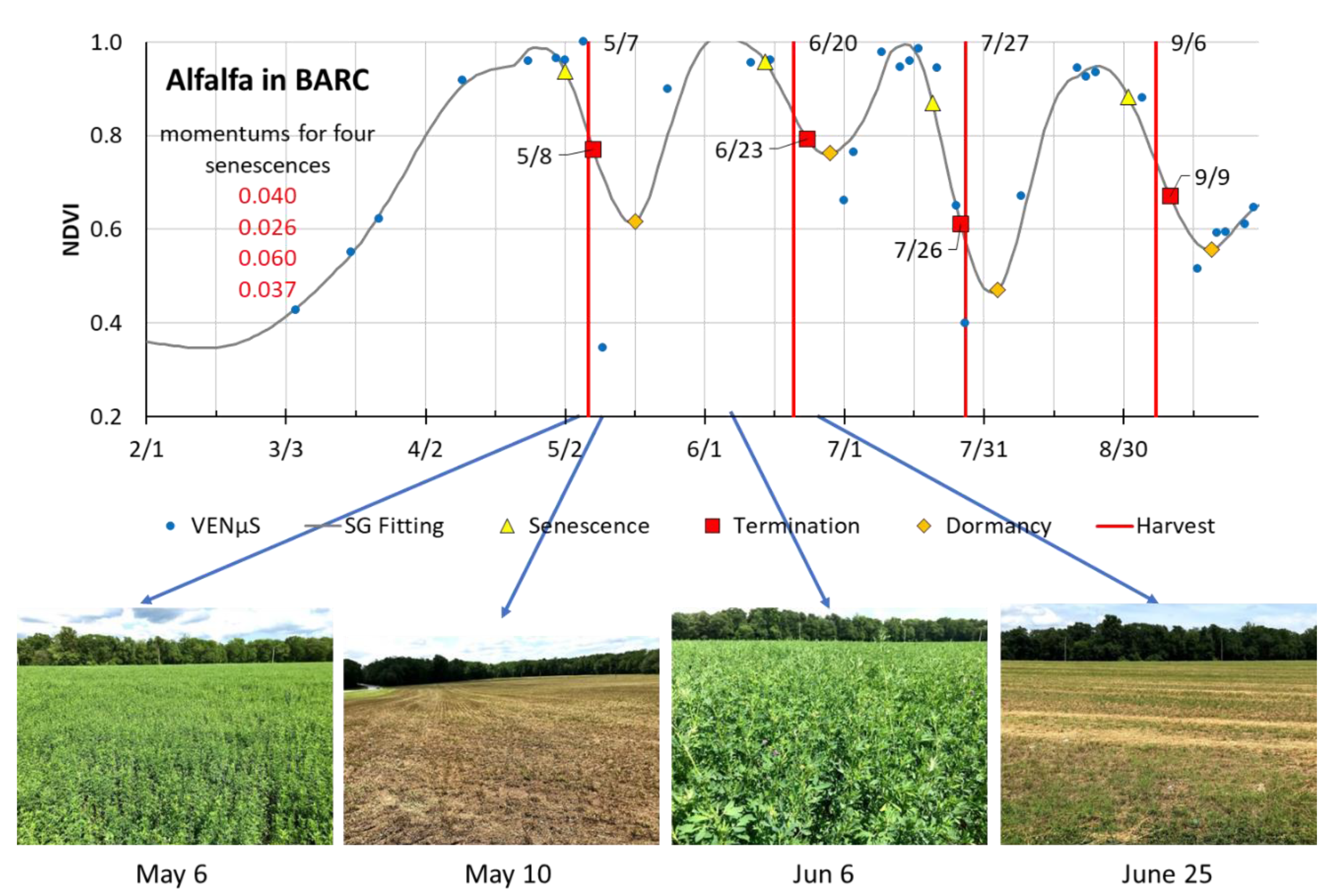


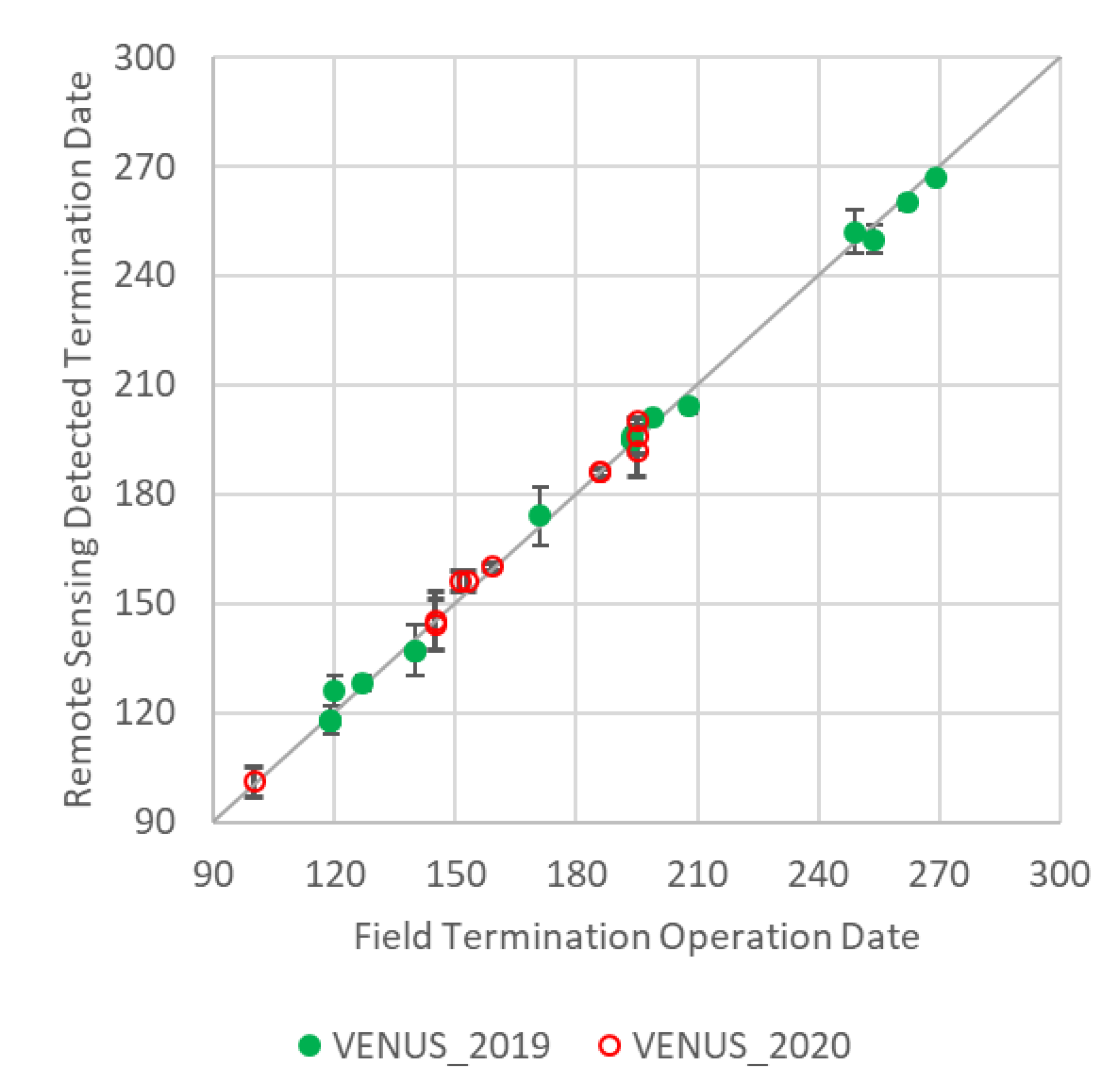

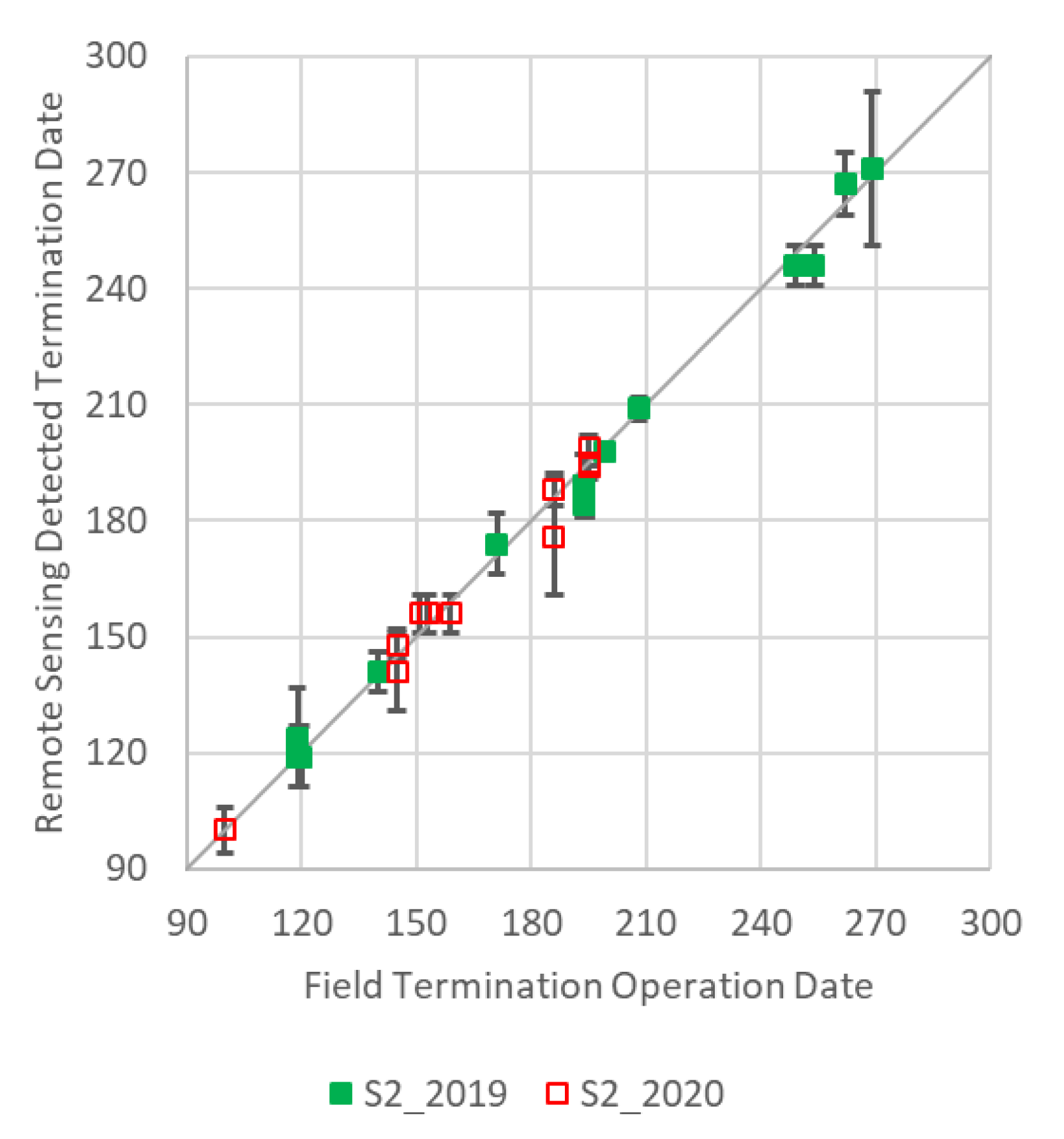


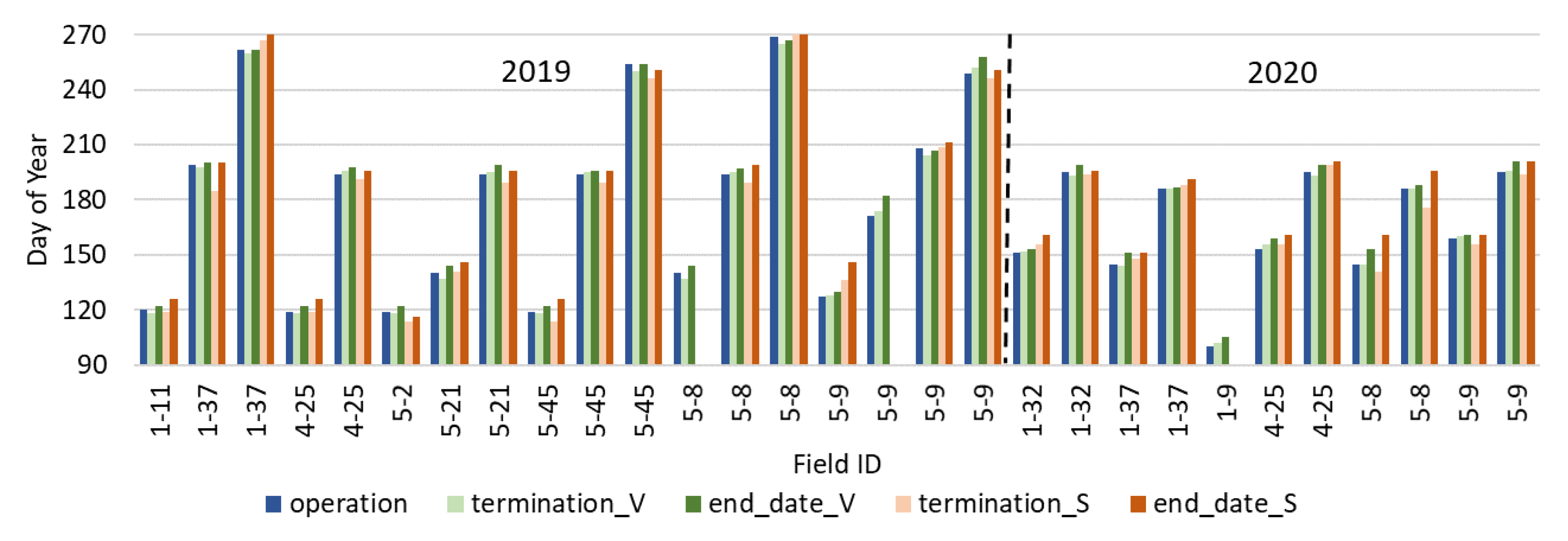
| Mean Bias (Days) | Mean Abs. Difference (Days) | RMSE (Days) | Coefficient of Determination (R2) | Mean Uncertainty (Days) | Percent of Missing | Percent of False Detection | |
|---|---|---|---|---|---|---|---|
| VENµS | 0.4 | 2.1 | 2.6 | 0.998 | 3.5 | 0.0% | 3.4% |
| Sentinel-2 | −1.4 | 4.0 | 5.1 | 0.987 | 6.1 | 6.9% | 10.3% |
Publisher’s Note: MDPI stays neutral with regard to jurisdictional claims in published maps and institutional affiliations. |
© 2020 by the authors. Licensee MDPI, Basel, Switzerland. This article is an open access article distributed under the terms and conditions of the Creative Commons Attribution (CC BY) license (http://creativecommons.org/licenses/by/4.0/).
Share and Cite
Gao, F.; Anderson, M.C.; Hively, W.D. Detecting Cover Crop End-Of-Season Using VENµS and Sentinel-2 Satellite Imagery. Remote Sens. 2020, 12, 3524. https://doi.org/10.3390/rs12213524
Gao F, Anderson MC, Hively WD. Detecting Cover Crop End-Of-Season Using VENµS and Sentinel-2 Satellite Imagery. Remote Sensing. 2020; 12(21):3524. https://doi.org/10.3390/rs12213524
Chicago/Turabian StyleGao, Feng, Martha C. Anderson, and W. Dean Hively. 2020. "Detecting Cover Crop End-Of-Season Using VENµS and Sentinel-2 Satellite Imagery" Remote Sensing 12, no. 21: 3524. https://doi.org/10.3390/rs12213524
APA StyleGao, F., Anderson, M. C., & Hively, W. D. (2020). Detecting Cover Crop End-Of-Season Using VENµS and Sentinel-2 Satellite Imagery. Remote Sensing, 12(21), 3524. https://doi.org/10.3390/rs12213524





